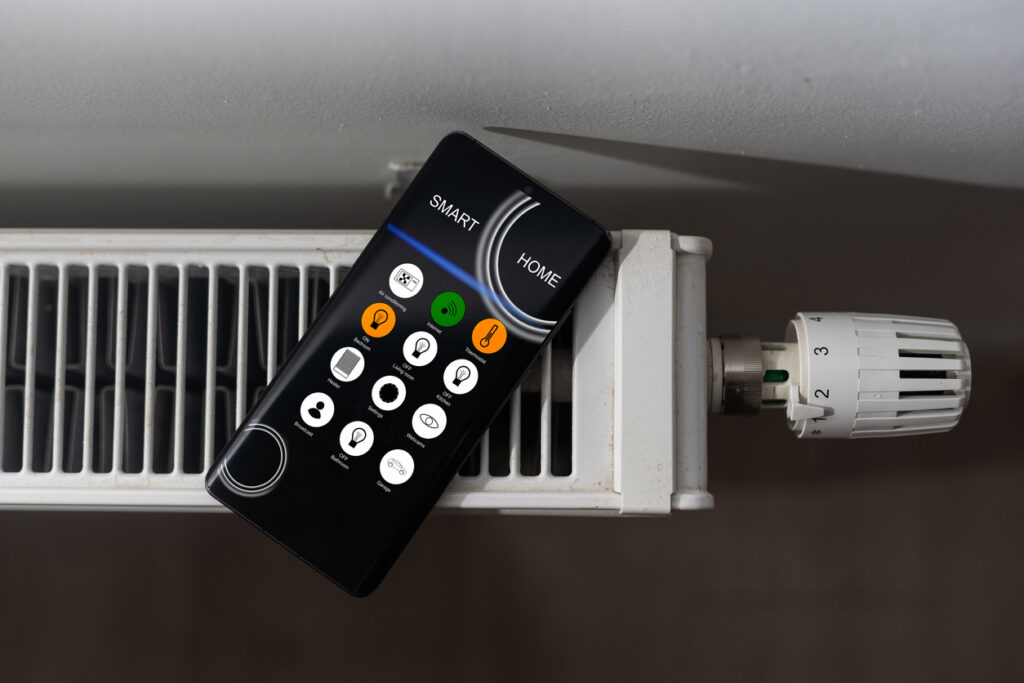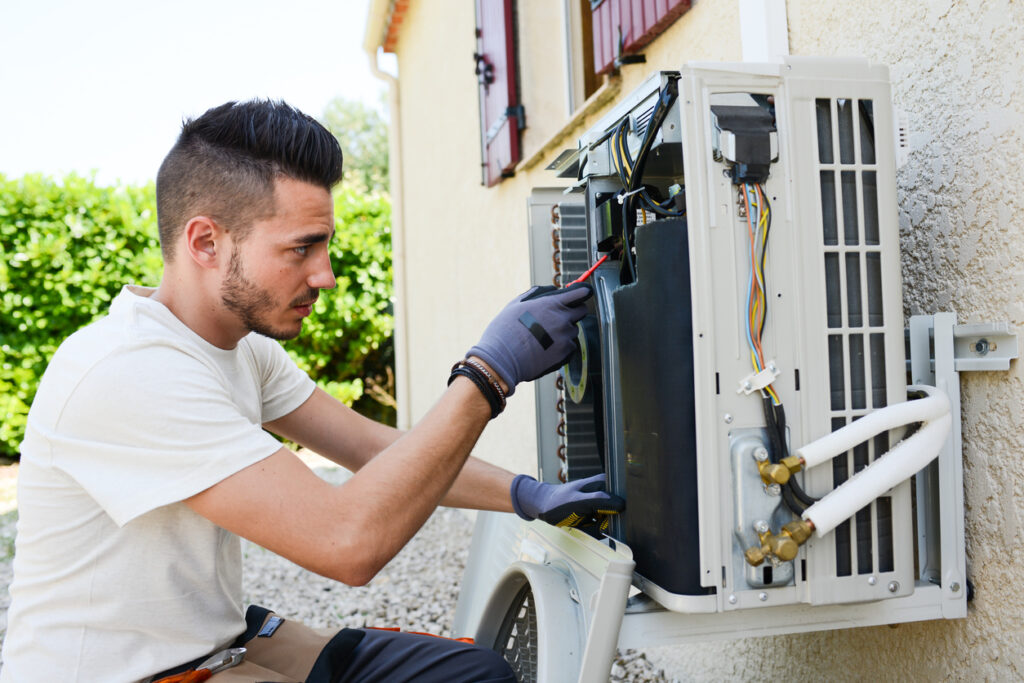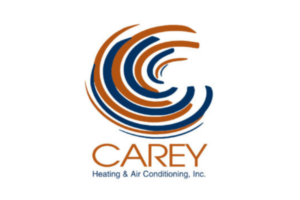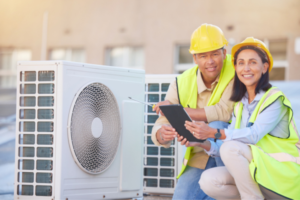Tech-Driven HVAC Solutions
An HVAC industry outlook must begin with a look at how new technologies are changing the industry. By now everyone is familiar with how technologies have changed our living spaces. We ask a digital assistant to play a certain playlist or turn the lights on at sunset. Web enabled technologies are now easily found in HVAC equipment. Think smart thermostats that adopt to user preferences by turning on heating when people are in the building, or AI driven HVAC systems that can optimize energy consumption.
These new HVAC technologies can deliver real time data on system performance and energy usage, automatically adjust temperature settings based on occupancy and weather conditions and allow remote monitoring so your HVAC service techs can diagnose issues or perform routine maintenance so there is less downtime overall. HVAC companies that encourage customers to invest in web enabled systems can provide better service overall. With the use of data analytics, it will be possible to forecast when HVAC gear is failing or needs maintenance based on historic performance data. Review of the data can also allow you to schedule maintenance at convenient times, expand the lifespan of HVAC gear by identifying issues before they become acute or lead to expensive shutdowns.
The Green Revolution in HVAC
The building industry is also undergoing a sea change as there is increased demand for sustainability and energy efficiency. This new emphasis on green solutions has led to HVAC innovations that help increase the longevity of the systems and equipment your company can install and service, including geothermal heating and cooling systems, and energy efficient HVAC units.
With the increasing focus in building science on energy conservation, there’s greater demand for products like high efficiency HVAC units with variable speed technologies and complex controls that can help your customers reduce their energy consumption. As well, some HVAC systems can now be powered with renewable energy sources like solar energy.
HVAC industry trends to watch include increased demand for items like thermostats that optimize heating and cooling patterns; energy management systems that analyze usage and offer recommendations for further savings; heat recovery systems that capture and reuse waste heat to improve overall energy efficiency.
Proactive Service Through Remote Monitoring

Rapidly changing technologies have also ushered in a new era of proactive HVAC innovation. Remote monitoring and predictive maintenance is now possible thanks to smart devices that can connect to the internet to upload data.
Remote monitoring allows you to review critical temperature controls including boiler water temperature as well as the temperature in ducts and AC units. Remote monitoring also provides alerts to water leaks and other malfunction issues like faulty evaporator coils, broken fittings, leaking humidifiers and damaged compressors.
Using data from smart HVAC devices allows companies to schedule preventative maintenance so there will be minimal downtime for the HVAC system, and longer system life overall. Your customers will see cost savings because remote monitoring will allow them to minimize downtime.
A service team can analyze and diagnose issues based on data about the system’s performance. The same data can also help decide whether an onsite visit will be necessary. To make remote monitoring work well, your service techs need to be trained and experienced in reviewing system data for conditions like pressure, water temperature, pH, pump status, tank levels, and flow rate.
Renewable Energy in HVAC Systems
There’s a shift in the HVAC industry to move to more renewable energy sources, such as solar panels, heat pumps, wind power, and biomass heating. By increasing reliance on sustainable energy sources, building owners can save money by cutting energy consumption while maintaining optimal indoor comfort.
Here are two examples of sustainable energy use in HVAC systems:
- Geothermal heat pumps in commercial buildings can provide energy savings up to 50% compared to conventional HVAC systems while reducing CO2 emissions by as much as 40%. And a shift to a heat pump will result in consistent and comfortable indoor temperatures.
- Residential buildings can implement solar powered air conditioning. This shift brings the benefit of greater energy independence, reduced electricity bills, and decreased maintenance costs over the lifetime of the solar powered air conditioner.
Renewable energy integration can lead to significant energy savings, while reduced greenhouse gas emissions contribute to more sustainable environments. Renewable energy fuels consistent and efficient HVAC systems that help building occupants enjoy more comfortable and satisfying indoor environment.
Addressing the HVAC Technician Shortage
There is an ongoing skilled labor shortage in the HVAC industry, which negatively affects service quality as well as the ability of companies to respond in a timely manner. The labor shortage in HVAC is due to an aging workforce and lack of interest among younger workers in entering skilled trades.
The Covid pandemic worsened the issue. The emphasis on home improvements, coupled with lower interest rates and stimulus checks meant there was a lot of new business for HVAC companies, but labor shortages meant companies struggled to meet demand.
For the HVAC service industry outlook to improve, companies need to be able to attract new employees. HVAC companies can bring in younger workers by emphasizing the use of technology, and showing how HVAC service techs require high skills and expertise in understanding data and building systems. Other incentives for new techs include publicizing the good pay and stability of the work as HVAC technicians.
Internships and mentoring programs can help new HVAC employees integrate better and stay in the industry. Recruiting, training, and mentoring employees is the best way to ensure that your company continues to provide excellent service for your customers.
Breathing Easier: The IAQ Revolution
Another lesson from the Covid pandemic was renewed demand for improving indoor air quality (IAQ). Indoor air can contain airborne particulates like pollen, mold spores, animal dander, pesticides, lead, and infectious bacteria and viruses. HVAC systems are used to maintain good indoor air quality by providing ventilation and filtration as well as temperature controls.
Ventilation and air filtration is crucial to preserve air quality levels. HVAC equipment can be used to filter out volatile organic compounds (VOCs) which are chemicals emitted by materials and products, detect elevated levels of carbon dioxide, and help regulate moisture and humidity as uncontrolled moisture indoors can lead to mold growth.
More than ever, commercial and residential buildings are making investments in HVAC systems like air purification technology, carbon dioxide monitors, and sulphur hexafluoride leak detectors to keep occupants safe.
Navigating HVAC Service Industry Regulations in 2024
In recent years, the US Department of Energy announced higher standards for the efficiency of air conditioners and heat pumps. These key regulatory changes will affect the equipment you deliver and service for your customers and how you manage your inventory.
There are new, more thorough standards for testing energy usage for air conditioners and heat pumps. These new testing procedures require increases in external static pressure on HVAC systems by up to five times in a move that better reflects field conditions of installed equipment.
This means that certain HVAC equipment that’s not compliant and has a manufacturing date older than 2022 can no longer be installed in certain regions. Check here for further information.
Field techs should be educated about these new minimum efficiency standards and rules for the regions where you operate. You’ll also need to educate your customers about these new standards. The good news is that these regulatory changes will likely save your customers some money on energy costs. You can offer to evaluate their existing equipment and help your customers plan for legacy unit replacement.

Today’s HVAC customers expect high value service for their HVAC needs.
Meeting Modern HVAC Service Expectations
As most HVAC service contractors know, the single best way to gain and retain valued customers is to treat every job and every call with courtesy and respect. Today’s HVAC customers want prompt service and high quality work, and they want their busy schedules to be respected.
Here’s how to meet modern HVAC service expectations:
- Teach your techs to listen. Your customers want to be able to present their problems and have a trained professional provide a solution.
- Arrive on time. Make sure your techs get to their appointments on time and deliver service in a reasonably timely manner.
- Follow up. After a job has been completed, connect with your customers to learn whether the service was completed satisfactorily, and make it right if they are unhappy.
- Spread the word. If a customer is enthusiastic about their experience, encourage them to provide a testimonial for your website or add a Google review to your business profile. Read more on marketing your HVAC company.
Protecting HVAC Data in a Connected World
Data security is a new concern for HVAC companies. There are significant benefits to connecting an HVAC system to the internet, including remote diagnosis and monitoring, but a connection to the internet means that it’s important to take data security seriously.
Although some devices like smart meters and HVAC unit sensors are not intended for web browsing, direct access to the internet makes them a target. That means that customers who utilize smart technologies must also incorporate an effective level of protection for HVAC data. Smart HVAC systems should be designed to incorporate encryption and include ongoing system upgrades and employee training on cybersecurity.
These precautions can add additional costs but are considerably less than the costs of an actual attack. There are free government resources available via the Cybersecurity and Infrastructure Security Agency (CISA) and National Institute of Standards and Technology (NIST) to help companies develop procedures and specifications for cybersecurity best practices in design and installation of HVAC control systems.
Conclusion
Sustainability, connectivity, longevity for the labor force, and customer service are key HVAC industry issues that HVAC service companies will need to stay current on. In order to be successful, companies must recognize the changes that are being demanded in their industry by staying informed, adapting to incorporate new equipment, integrating new technologies that are sustainable and energy saving, and building a skilled labor force.
All in one software like Shafers that’s made to help manage HVAC service companies can help you stay competitive and adaptable in the evolving industry.



